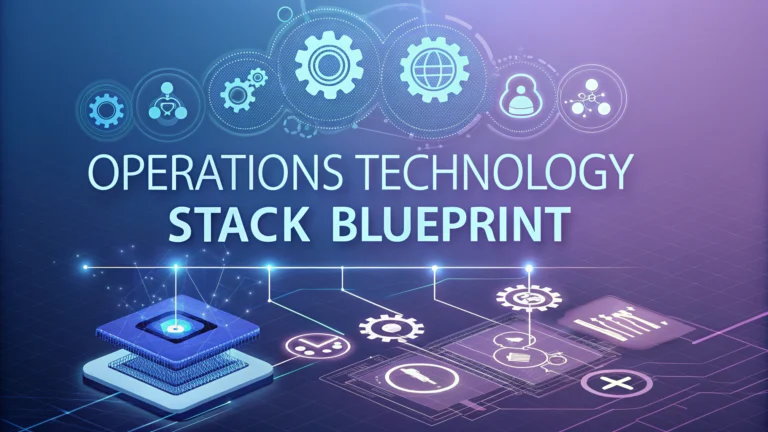A well-designed operations technology stack helps organizations streamline processes, reduce costs, and improve overall efficiency.
This guide focuses on building and optimizing technology infrastructure that supports core business operations while maintaining security and scalability.
Understanding the key components of an operations tech stack allows leaders to make informed decisions about tools and systems that drive organizational success.
Core Components of Operations Technology Stack
- Enterprise Resource Planning (ERP) – SAP, Oracle, Microsoft Dynamics
- Customer Relationship Management (CRM) – Salesforce, HubSpot, Zoho
- Supply Chain Management – Manhattan Associates, JDA Software
- Business Intelligence – Tableau, Power BI, Looker
- Project Management – Monday.com, Asana, Jira
Security and Compliance Considerations
Implement role-based access control (RBAC) to manage user permissions and protect sensitive data.
Regular security audits and compliance checks help maintain data integrity and meet industry regulations.
- ISO 27001 certification for information security
- GDPR compliance for data protection
- SOC 2 certification for service organizations
Integration and Automation
| Integration Type | Tools | Benefits |
|---|---|---|
| API Integration | MuleSoft, Dell Boomi | Seamless data flow between systems |
| Workflow Automation | Zapier, Workato | Reduced manual tasks |
| RPA | UiPath, Blue Prism | Process automation at scale |
Performance Monitoring
- Application Performance Management (APM)
- New Relic
- Dynatrace
- AppDynamics
- Infrastructure Monitoring
- Nagios
- Datadog
- Prometheus
Cost Optimization Strategies
Regular assessment of software licenses and subscriptions prevents unnecessary spending.
Cloud resource optimization tools like AWS Cost Explorer or Azure Cost Management provide spending insights.
Implementing a centralized procurement process helps track and manage technology expenses.
Building for the Future
Choose scalable solutions that support business growth and changing operational needs.
Maintain documentation and training programs to ensure effective technology adoption.
Consider cloud-native solutions for flexibility and reduced infrastructure maintenance.
Contact technology vendors directly for demos and pricing: Gartner Peer Reviews provides verified vendor information and user reviews.
Implementation Best Practices
Create a phased rollout plan to minimize disruption to existing operations.
Establish clear KPIs to measure technology stack performance and ROI.
- User adoption rates
- System uptime and reliability
- Process efficiency improvements
- Cost savings metrics
Change Management and Training
Develop comprehensive training programs for all user levels across the organization.
Key Training Components
- Role-specific workflows
- Security awareness
- System integration understanding
- Troubleshooting procedures
Vendor Management
Establish strong relationships with technology vendors through regular communication and performance reviews.
- Quarterly business reviews
- Service level agreement monitoring
- Feature request tracking
- Support response times
Driving Operational Excellence Through Technology
A well-implemented operations technology stack serves as the foundation for organizational efficiency and growth.
Regular assessment and optimization of technology components ensure continued alignment with business objectives.
Successful organizations maintain flexibility in their tech stack to adapt to emerging technologies and changing market demands.
- Continuously evaluate new technologies
- Monitor industry trends
- Maintain scalable infrastructure
- Foster innovation culture
FAQs
- What is an Operations Technology Stack?
An Operations Technology Stack is a comprehensive collection of integrated software tools and platforms that support and automate core business operations, including ERP systems, workflow management tools, automation software, and data analytics platforms. - What are the key components of an Operations Technology Stack?
The key components typically include enterprise resource planning (ERP), customer relationship management (CRM), supply chain management systems, business intelligence tools, workflow automation software, and data integration platforms. - How does cloud computing impact the Operations Technology Stack?
Cloud computing enables scalable, flexible, and cost-effective deployment of operational technologies, allowing for remote access, automatic updates, and improved integration between different stack components. - What role does data security play in the Operations Technology Stack?
Data security is crucial in protecting sensitive operational information, requiring robust encryption, access controls, compliance measures, and regular security audits across all technology stack components. - How can organizations ensure successful implementation of an Operations Technology Stack?
Success requires careful planning, stakeholder buy-in, proper integration testing, comprehensive staff training, clear documentation, and a phased implementation approach with regular performance monitoring. - What are the integration challenges in Operations Technology Stack?
Common challenges include legacy system compatibility, data standardization, API management, maintaining system performance, and ensuring seamless communication between different stack components. - How does artificial intelligence enhance the Operations Technology Stack?
AI enables predictive analytics, automated decision-making, process optimization, anomaly detection, and intelligent automation of routine operational tasks. - What metrics should be tracked to measure Operations Technology Stack effectiveness?
Key metrics include system uptime, process efficiency gains, cost savings, error reduction rates, user adoption rates, ROI on technology investments, and operational performance improvements. - How often should an Operations Technology Stack be updated?
Updates should be implemented regularly based on business needs, technology advancements, security requirements, and vendor update schedules, typically involving quarterly patches and annual major updates. - What is the role of mobile technology in the Operations Technology Stack?
Mobile technology enables remote access to operational systems, real-time data monitoring, field service management, and improved collaboration across distributed teams.
